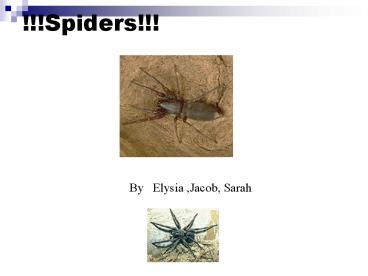Spiders - PowerPoint PPT Presentation
1 / 11
Title:
Spiders
Description:
The female Black Widow Spider waits upside down on her ragged web, guarding her ... quickly to a dark corner or some other shelter when their web Is disturbed. ... – PowerPoint PPT presentation
Number of Views:79
Avg rating:3.0/5.0
Title: Spiders
1
!!!Spiders!!!
By Elysia ,Jacob, Sarah
2
The female Black Widow Spider waits upside down
on her ragged web, guarding her egg sac and
flashing her red warning mark. The Black
WidowBlack Widows are shy creatures and they
usually retire quickly to a dark corner or some
other shelter when their web Is disturbed. The
bite of a black widow is dangerous, but rarely
fatal to a healthy person. The male does not
bite. A glossy black spider. The female's
abdomen is almost round with a red hourglass
pattern on the underside. The male is smaller,
marked with red and white along the sides.
3
Did you know that the female spider eats the male
spider? The red dot that is on the back of the
spider is called an hourglass.
4
There are more then 35,000 different kind of
spiders. They got up to eight eyes.Spiders eat
insects and other spiders they eat amphibian and
lizards and lots more.
5
Wolf spiders are usually large, hairy spiders
that are not associated with webs. They look much
worse than they are. Household pest in the fall
when they are looking for a warm place for
winter found around doors, windows, house
plants, basements and garages.
6
Wolf spider with a lot of babies in its
sack.Same as other spiders it dies after the
young spiders are born.
7
There are about 34,000 named species of spiders
in the world. Some people estimate the total
number to be closer to 170,000. There are about
4000 named species of spiders in North America.
8
Garden spiders are orb weavers, known for their
intricate orb-shaped webs. W eb building is a
complex process support lines are constructed
first then the radial lines and finally the
spiraling strands are spun from the center
outward. Without training from adults, even the
tiniest just-hatched spider lings are able to
spin silk and weave webs. Another orb weaver,
nephila, builds an extremely thick and strong
web, up to eight feet in diameter.
9
The gardener spider is spinning a web.
10
he 1 1/8-inch long golden garden spider, Argiope
aubrietia, is one of three local species of
argiope orb weavers. The adult female is
predominately black with yellow or orange
markings on the abdomen, and circular bands of
yellow evident on the legs. Range and Habitat
11
Bibliography
school notes.com Wild life.com Animals
Discovery.com Accessexcellen.org Thank you for
the information.































